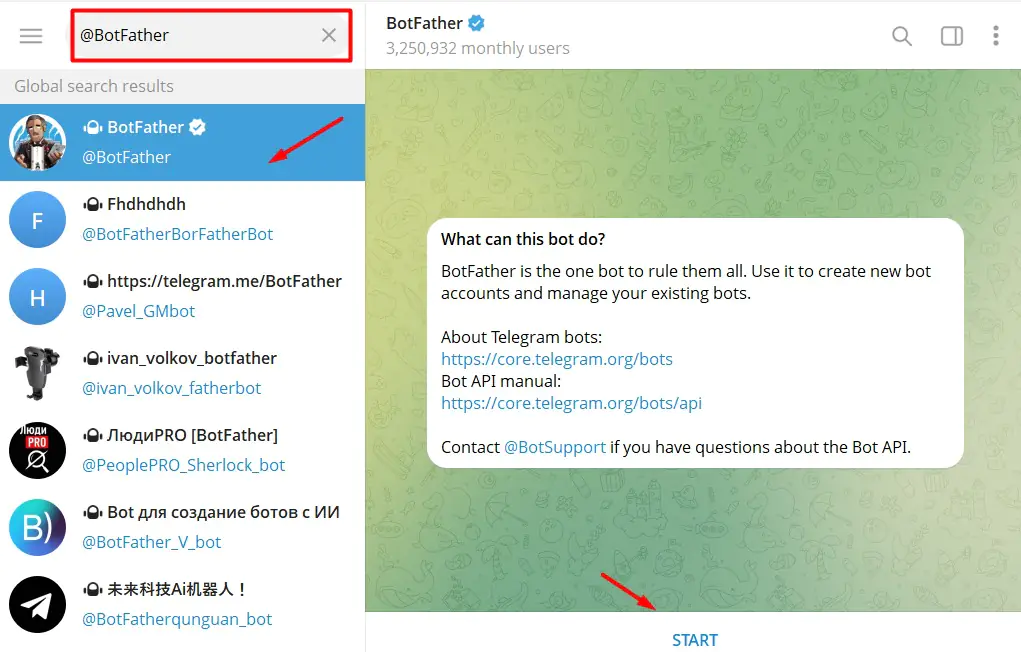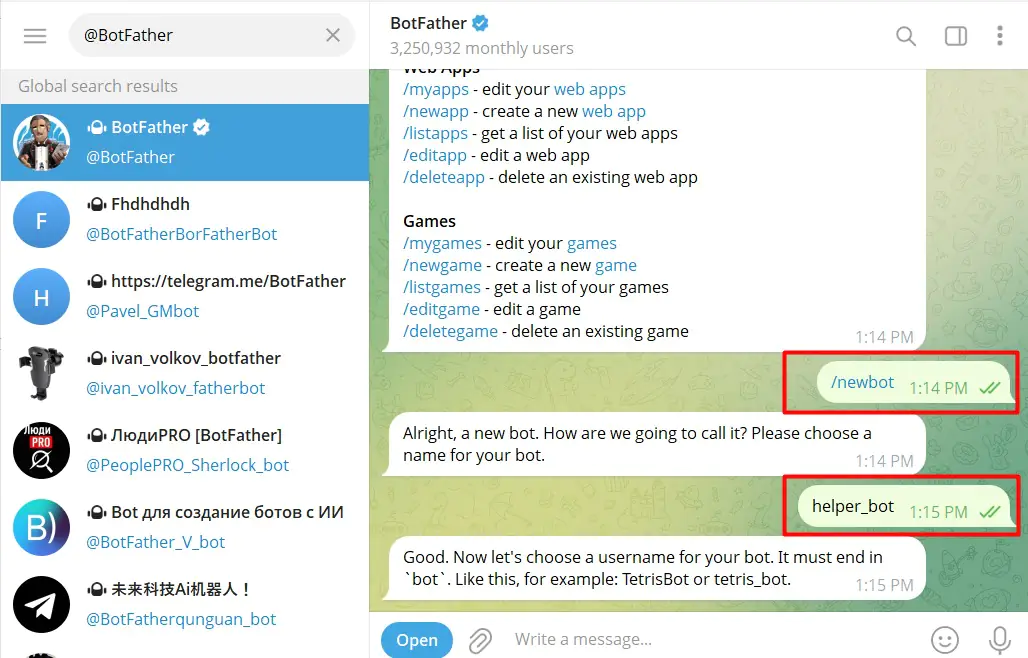How to Create a Telegram Bot – Complete Beginner’s Guide


Telegram bots are automatic assistants built right into the messenger. They can respond to messages, execute commands, send notifications, work as mini-applications, and even manage business processes.
Due to its simple API and accessibility, bots have become a popular tool for both developers and non-technical users.
Do you want to learn how to create a Telegram bot? This article presents several effective methods suitable for both beginners and professionals.
What is a Telegram Bot and How Does It Work?
A Telegram bot is a virtual conversation partner inside a messenger, controlled by a program code. It does not require a constant human presence and can automatically respond to user actions: commands, messages, button clicks, and other events.
The bot works through the Telegram Bot API, a special interface that allows the developer to receive information from the user and send responses. This makes the bot a universal tool: it can take orders, conduct chat support, collect data, remind you of events, integrate with external systems, and control smart home devices.
In fact, the Telegram bot turns an ordinary chat into an interactive application, accessible directly from the messenger — quickly, conveniently, and without installing additional programs.
*Discover: Track Your Friends’ Activity Through Telegram Spy.
Prerequisites: What You Need Before You Create a Telegram Bot
To create a Telegram bot from scratch, you do not need complicated tools or expensive equipment — just a basic set of resources:
- A Telegram account — used to communicate with BotFather and manage the bot. BotFather is the official Telegram bot through which you create a new bot and receive a unique access token.
- The API token — the key that binds your bot to the code. The bot cannot work without it.
- Minimal programming knowledge — any language with HTTP request support is suitable, but Python, JavaScript, or PHP are most often used.
- A code editor — such as Visual Studio Code, PyCharm, or even online platforms like Replit.
With this basic set, you can create a bot and develop its functionality as your tasks and experience grow.
By the way, if you do not plan to create a Telegram bot yourself but just want to use a ready-made solution, pay attention to Nicegram. This is a user-friendly application where the built-in AI bot is already available in every chat. You do not need to configure or install anything separately: the bot is automatically active and ready to answer your questions, help with correspondence, or execute simple commands.
It is an ideal option for those who want to get the capabilities of artificial intelligence without unnecessary technical steps. Just download Nicegram — and the smart assistant is already with you.
How to Create a Bot on Telegram Using BotFather
The creation of a Telegram bot begins with BotFather. Here is a step-by-step instruction on how to work with BotFather:
Step 1: Find the BotFather. Open Telegram and type @BotFather into the search. Go to the chat and click Start.

Step 2: Start creation. Send a command — /newbot
Step 3: Enter the name. Enter a name — it will be displayed in the bot’s profile (for example, a Bot Assistant).
Step 4: Create a username. Enter a unique name ending with bot (for example, helper_bot). It will be part of the link to the bot.

Step 5: Get the token. BotFather will issue a token, which is the key for connecting to the Telegram API. Keep it — you will need it during development.
That’s it. The bot has been created. Now you can connect it to the code and start developing the functionality.
How to Create a Bot in Telegram With No Coding
If you do not know how to code, you can use no-code platforms — services with visual constructors. The most popular are Manybot and Flow XO.
How does it work? Firstly, create a bot through BotFather and get a token. Then connect the bot to the platform, and using a simple interface, you can configure commands, automatic responses, menus, and other scripts — without programming.
Here are the main advantages of this method:
- Fast and simple, without programming knowledge.
- Ready-made templates for different tasks.
- Convenient visual control.
Here are the disadvantages:
- Limited functionality compared to programming.
- Often paid tariffs with advanced features.
- Dependence on the platform.
Anyway, no-code solutions are an excellent choice for quickly creating simple and functional Telegram bots without technical knowledge. This is a convenient start for small businesses, bloggers, and beginners who want to automate communication with their audience without unnecessary difficulties.
How to Create a Telegram Bot Step-by-Step With Code
Creating a Telegram bot using Python is easy and fast. The python-telegram-bot library takes over the complex work with the API, allowing you to focus on logic:
Step 1. Install the library. Enter in the terminal —- pip install python-telegram-bot
Step 2. Get a token. Through BotFather, create a bot, and copy the unique token.
Step 3. Write the code. Create a file bot.eng and insert:
from telegram import Update
from telegram.ext import Updater, CommandHandler, CallbackContext
def start(update: Update, context: CallbackContext):
update.message.reply_text(“Hello! I am your bot.”)
def main():
updater = Updater(“YOUR_TOKEN_HERE “, use_context=True)
dp = updater.dispatcher
dp.add_handler(CommandHandler(“start”, start))
updater.start_polling()
updater.idle()
if __name__ == ‘__main__’:
main()
*Note: Replace “YOUR_TOKEN_HERE” with your actual token.
Step 4. Launch the bot. Run in the terminal — python bot.eng.
That’s it! The bot is ready to work — it responds to the command /start. This is how your journey begins in the world of Telegram bots. Next, you can expand the functionality by adding commands and interactive elements.
How to Create a Telegram Bot Tutorial for Beginners
Creating a Telegram bot is an effective way to automate communication with users. Follow the simple steps:
Step 1. Registration via BotFather. In Telegram, find @BotFather → send /newbot → specify the name and username of the bot. Get an API token.
Step 2. Preparation of the environment. Install Python 3.6+, then run — pip install python-telegram-bot.
Step 3. Creating a script. In the file bot.eng write:
from telegram import Update
from telegram.ext import Updater, CommandHandler, CallbackContext
def start(update: Update, context: CallbackContext):
update.message.reply_text(“Hello! I am your bot.”)
def main():
updater = Updater(“YOUR_TOKEN_HERE “, use_context=True)
dp = updater.dispatcher
dp.add_handler(CommandHandler(“start”, start))
updater.start_polling()
updater.idle()
if __name__ == ‘__main__’:
main()
*Note: Replace “YOUR_TOKEN_HERE” with your actual token.
Step 4. Launch and test. Send /start in a chat with a bot and get a reply.
This simple template will help you create a functional Telegram bot with the possibility of further development.
Adding Commands and Custom Keyboard to Your Telegram Bot
Telegram has a special bot, @BotFather, which helps you create and configure your bots. To make your commands appear in the user’s menu, do this:
- Open a chat with @BotFather.
- Write /setcommands.
- Enter the commands in this format:
- start – Get started;
- help – Help;
- info – Information.
Now users will be able to see and press these commands directly in the chat.
Also, you can add a custom keyboard. It is a set of buttons under the input field that help the user quickly select actions. In Python with the python-telegram-bot library, this is implemented like this:
from telegram import ReplyKeyboardMarkup
def start(update, context):
buttons = [[‘Hello’, ‘Help’], [‘Info’]]
keyboard = ReplyKeyboardMarkup(buttons, resize_keyboard=True)
update.message.reply_text(‘Select the button:’, reply_markup=keyboard)
When the user opens the chat with the bot and enters the /start command, buttons will appear that can be clicked.
Using Webhooks vs. Polling in Telegram Bot Development
There are two ways to receive messages when creating a Telegram bot: polling and webhooks.
Polling is a bot’s regular requests to Telegram servers to check for new messages. This method is simple and suitable for beginners, without requiring an HTTPS server.
Webhooks allow Telegram to automatically send messages to your server by URL, which is faster and more efficient, but requires setting up a reliable HTTPS server and web development knowledge.
Popular Use Cases for Telegram Bots
Popular use cases for Telegram bots include:
- Weather bots — provide an up-to-date weather forecast at the user’s request.
- News bots — promptly deliver the latest news and updates.
- Chatbots — conduct a dialogue with users, answer questions, and entertain.
- Support service — helps quickly resolve technical and service issues of clients.
- Task automation — perform repetitive actions, such as reminders or mailing lists.
- Polls and votes — collect feedback and opinions from the audience.
- Community management — chat moderation, message filtering, and role allocation.
These areas make Telegram bots a universal tool for business and personal use.
Best Practices When Creating a Telegram Bot
Creating a Telegram bot is not just about writing code. For a bot to be useful, safe, and user-friendly, it is important to think through the details. Below are the key recommendations that will help you make your bot really high-quality:
- Naming
Choose a simple, memorable name that reflects the essence of the bot. Username must be unique and end with bot. A good name is the first step towards a user’s trust.
- Token security
Never place a bot token in the public domain (for example, on GitHub). Store it in an .env file or environment variables. This will protect your bot from hacking.
- Data privacy
Collect only the data that is really needed. Respect users’ personal information and comply with GDPR principles (if you work with an audience from the EU).
- Convenient interaction
Use buttons, commands, and clear answers. Make communication simple and understandable, especially for new users. Add a welcome message and hints.
- Error handling
Program the bot so that it responds correctly to unexpected situations: displays an error message or suggests an alternative. Also, log errors for debugging and improving the bot.
*Note: These basic principles will help you create not only a working but also a reliable, convenient, and secure Telegram bot.
Common Errors and How to Fix Them
Developing a Telegram bot may seem simple, but even beginners quickly make mistakes that interfere with the work of the bot. Below are the most common problems and proven solutions:
#1 Invalid token → Check the token from BotFather and remove the extra characters.
#2 Connection problems (timeout) → Make sure the Internet is stable, switch to Webhook if necessary.
#3 The commands do not work → Make sure that the commands are registered in BotFather and correctly processed in the code.
#4 Error when entering non-standard data → Add exception handling and incoming data type checking.
#5 The token was publicly available → Immediately reissue the token and store it in the .env file.
By avoiding these typical mistakes, you can make the Telegram bot more reliable, secure, and user-friendly.
Final Thoughts on How to Create a Telegram Bot
Developing a Telegram bot is not only a useful skill but also an affordable tool for solving a wide variety of tasks, from automation to interacting with an audience. With a clear goal, basic knowledge, and suitable tools such as BotFather and the python-telegram-bot library, even a novice user can create a functional and secure bot from scratch.
The key to success is a step-by-step approach: a well-thought-out name, correct token setup, user-friendly interface, data protection, and stable operation. Following this path, you will be able to implement both a simple information bot and a complex service with advanced features.





